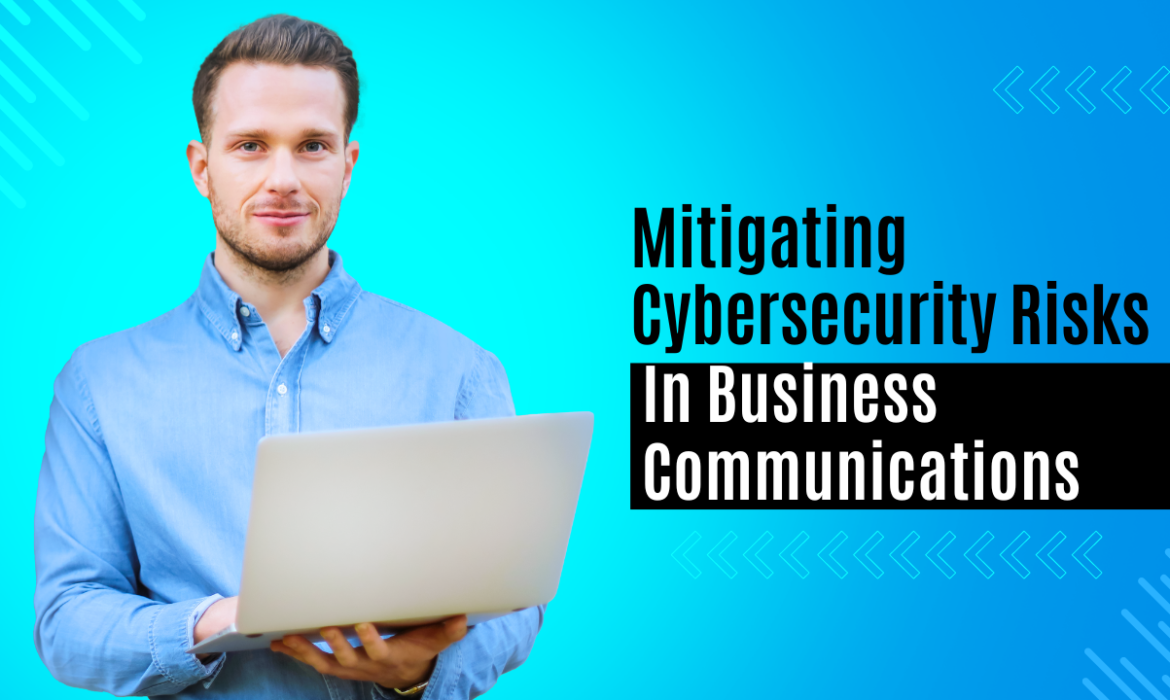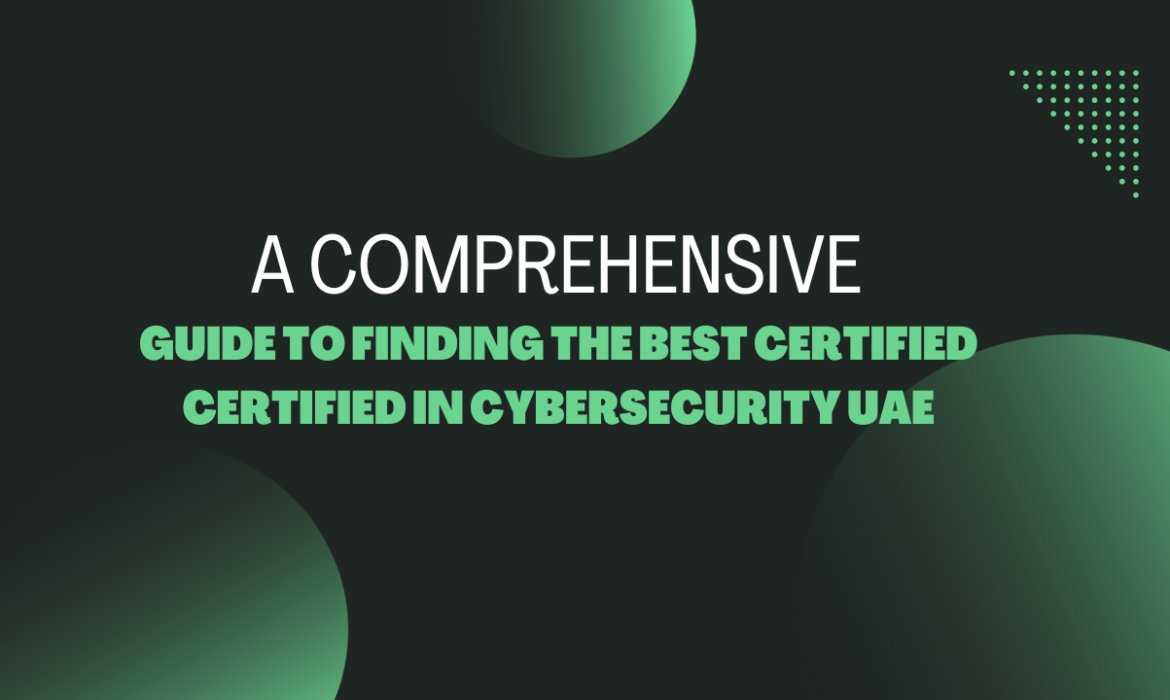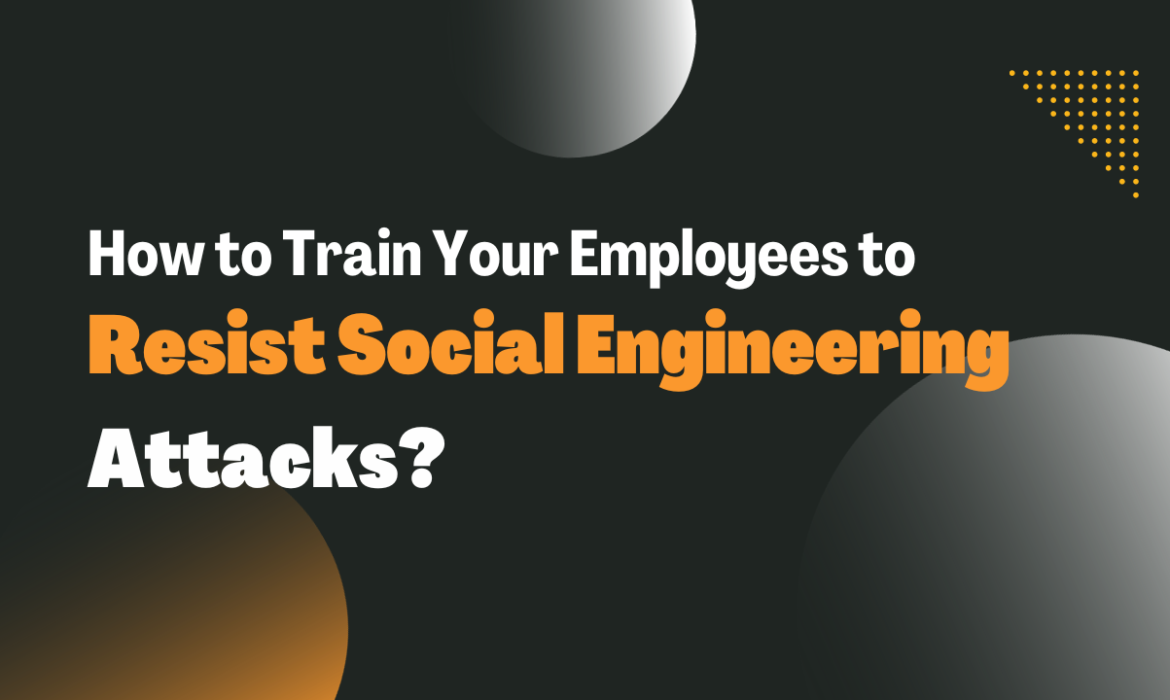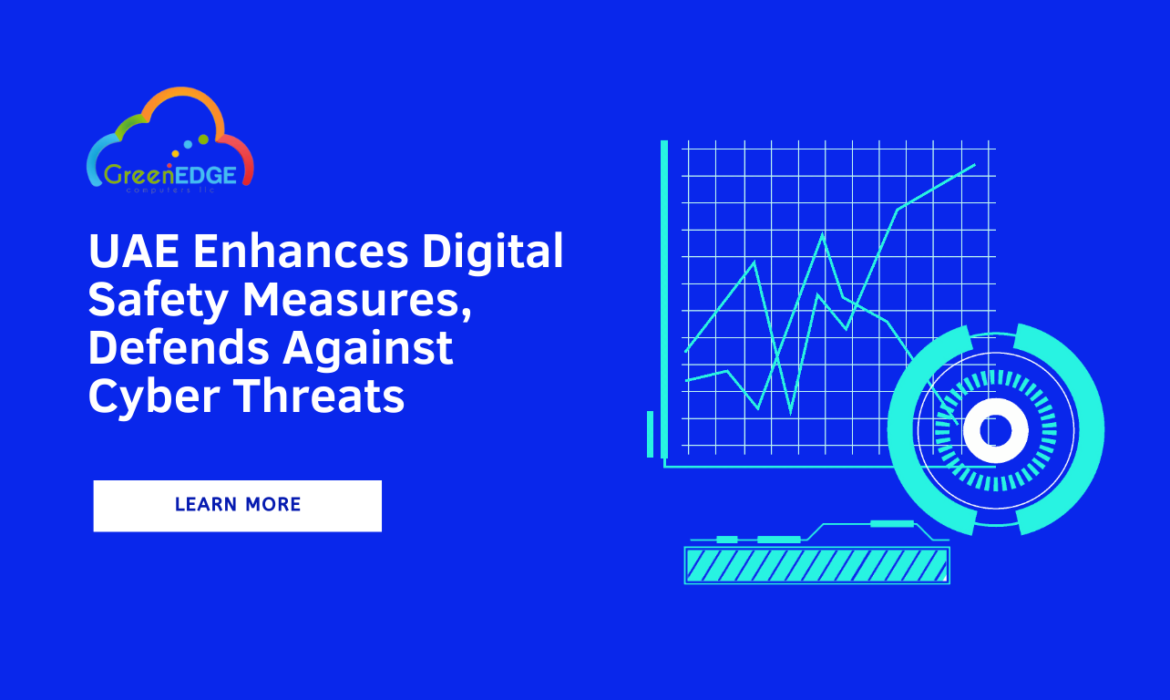Mitigating Cybersecurity Risks In Business Communications
In the fast-paced digital landscape of today’s business world, communication is the lifeblood that keeps organizations thriving. Whether it’s emails, instant messaging, video conferencing, or collaborative platforms, businesses rely heavily on various communication channels to keep operations smooth and efficient. However, with the increasing reliance on technology comes the escalating threat of cybersecurity risks that can jeopardize sensitive information and disrupt business operations. In this blog post, we’ll delve into the challenges posed by cybersecurity risks in business communications and explore effective strategies to mitigate these threats.
Understanding the Landscape of Cybersecurity Risks
The realm of cybersecurity risks in business communications is vast and continually evolving. From phishing attacks and malware infections to data breaches and ransomware, the adversaries are becoming more sophisticated in their techniques. Communication channels that are not adequately secured can serve as entry points for cybercriminals to exploit vulnerabilities, leading to severe consequences for the affected organizations.
Phishing Attacks
Phishing attacks remain one of the most prevalent and insidious threats in the cybersecurity landscape. Cybercriminals often disguise themselves as trustworthy entities to trick individuals into revealing sensitive information such as login credentials or financial details. In the context of business communications, phishing attacks can manifest through deceptive emails, messages, or even fraudulent websites that impersonate legitimate platforms.
Malware Infections
Malware, encompassing viruses, trojans, and ransomware, poses a significant threat to business communication systems. Malicious software can infiltrate networks through seemingly innocuous files or links, compromising the integrity of data and disrupting normal business operations. Once inside a network, malware can quickly spread through communication channels, causing widespread damage.
Data Breaches
Data breaches involve unauthorized access to sensitive information, and they can have severe consequences for businesses. Whether it’s customer data, financial records, or intellectual property, a data breach can lead to reputational damage, legal repercussions, and financial losses. In the context of business communications, compromised accounts or insecure channels can become entry points for attackers to gain unauthorized access.
Also Read: 6 Signs That Your Cybersecurity Posture Needs an Upgrade
Strategies for Mitigating Cybersecurity Risks
As the landscape of cybersecurity risks evolves, so too must the strategies employed by businesses to safeguard their communication channels. Here are several effective strategies to mitigate cybersecurity risks in business communications:
Employee Training and Awareness
One of the first lines of defense against cybersecurity threats is a well-informed and vigilant workforce. Conduct regular training sessions to educate employees about the latest cybersecurity threats, including phishing tactics and social engineering techniques. By raising awareness, employees are better equipped to recognize and report suspicious activities, reducing the risk of falling victim to cyberattacks.
Secure Communication Platforms
Choosing and implementing secure communication platforms is paramount in mitigating cybersecurity risks. Opt for platforms that employ end-to-end encryption, multi-factor authentication, and other robust security measures. Secure communication tools not only protect sensitive data but also ensure the confidentiality and integrity of business conversations.
Regular Security Audits and Assessments
Regularly conduct security audits and assessments to identify and address vulnerabilities in communication systems. This proactive approach helps businesses stay ahead of potential threats by identifying weak points in their infrastructure and implementing necessary security patches and updates.
Strong Password Policies
Enforce strong password policies across all communication channels. Encourage the use of complex passwords and regular password changes to minimize the risk of unauthorized access. Consider implementing biometric authentication or single sign-on solutions to enhance security without sacrificing user convenience.
Email Security Measures
Email remains a primary target for cybercriminals, making robust email security measures essential. Implement email filtering systems to detect and block phishing attempts and malicious attachments. Additionally, educate employees about the importance of verifying email addresses and avoiding clicking on suspicious links.
Endpoint Security
As employees often access business communication channels from various devices, ensuring the security of endpoints is crucial. Implement endpoint protection solutions to detect and mitigate malware threats on devices connected to the business network. Regularly update and patch endpoint software to address known vulnerabilities.
Incident Response Plan
Develop a comprehensive incident response plan to address cybersecurity incidents swiftly and effectively. This plan should outline the steps to be taken in the event of a security breach, including communication protocols, containment measures, and recovery strategies. Regularly test and update the incident response plan to ensure its effectiveness.
Data Encryption
Implement encryption for sensitive data both in transit and at rest. Encryption adds an additional layer of protection to prevent unauthorized access even if communication channels or storage systems are compromised. This is particularly crucial for businesses that handle sensitive customer information or proprietary data.
Vendor Security Assessments
If your business relies on third-party vendors for communication tools or services, conduct thorough security assessments of these vendors. Ensure that they adhere to industry best practices in cybersecurity and have robust security measures in place. Weaknesses in vendor security can expose your organization to additional risks.
Continuous Monitoring and Adaptation
Cybersecurity is an ever-evolving landscape, and organizations must continuously monitor the threat landscape and adapt their strategies accordingly. Implement tools and practices for continuous monitoring of communication systems, and stay informed about emerging threats and vulnerabilities. Regularly update security policies and measures to align with the evolving nature of cybersecurity risks.
Also Read: 7 Cybersecurity Steps Every SMB Should Take
Conclusion
Mitigating cybersecurity risks in business communications is an ongoing and multifaceted effort that requires a combination of technological solutions, employee awareness, and proactive measures. By adopting a comprehensive approach to cybersecurity, businesses can create a secure communication environment that protects sensitive information, preserves business continuity, and instills confidence among stakeholders. As the digital landscape continues to evolve, organizations must remain vigilant and adaptive in their cybersecurity strategies to stay one step ahead of cyber threats. Through a combination of education, technology, and proactive measures, businesses can fortify their communication channels and navigate the digital landscape with confidence.
Unveiling the Power of Vulnerability Assessment Tools: Safeguarding Your Digital Fortresses
In the dynamic landscape of cybersecurity, staying one step ahead of potential threats is paramount. As businesses increasingly rely on digital platforms, the need for robust security measures has never been more critical. In this blog post, we will delve into the realm of vulnerability assessment tools, shedding light on their significance, functionalities, and the pivotal role they play in fortifying digital infrastructures.
Understanding Vulnerability Assessment:
Vulnerability assessment is a proactive approach to identifying and mitigating potential security risks in a system. It involves a systematic review of software, networks, and other IT assets to pinpoint vulnerabilities that could be exploited by malicious actors. The ultimate goal is to bolster the organization’s security posture and protect sensitive data from unauthorized access.
Key Functions of Vulnerability Assessment Tools:
Scanning for Weaknesses:
- Vulnerability assessment tools conduct comprehensive scans of a system, identifying potential weak points. These could include outdated software, misconfigurations, or unpatched vulnerabilities that might be exploited by cyber threats.
Risk Prioritization:
- Not all vulnerabilities pose an equal threat. These tools prioritize risks based on severity, helping organizations focus on addressing the most critical issues first. This ensures that resources are allocated efficiently to mitigate the most significant threats.
Compliance Monitoring:
- Many businesses operate in industries with stringent regulatory requirements. Vulnerability assessment tools assist in ensuring compliance with industry standards by continuously monitoring and reporting on vulnerabilities that could lead to compliance breaches.
Real-time Monitoring:
- The cybersecurity landscape is dynamic, with new threats emerging regularly. Vulnerability assessment tools provide real-time monitoring, enabling organizations to promptly respond to potential risks and fortify their defenses.
Popular Vulnerability Assessment Tools:
Nessus:
- Nessus is a widely used vulnerability scanner known for its extensive vulnerability database and efficient scanning capabilities. It provides in-depth analysis and produces detailed reports to aid in the remediation process.
OpenVAS:
- OpenVAS is an open-source vulnerability scanner that offers a cost-effective solution without compromising on functionality. It’s regularly updated to address new vulnerabilities and includes a user-friendly interface.
Qualys:
- Qualys is a cloud-based vulnerability management platform that provides a holistic view of an organization’s security posture. Its scalability and continuous monitoring make it a preferred choice for enterprises of all sizes.
Acunetix:
- Acunetix is a web application security scanner designed to identify vulnerabilities in web applications. It helps organizations secure their web assets by detecting and addressing potential threats specific to web-based environments.
Benefits of Implementing Vulnerability Assessment Tools:
Proactive Risk Mitigation:
- By identifying vulnerabilities before they can be exploited, organizations can proactively address potential risks, reducing the likelihood of a security breach.
Resource Optimization:
- Vulnerability assessment tools prioritize risks, allowing organizations to allocate resources efficiently and focus on the most critical security issues.
Comprehensive Security Posture:
- Continuous monitoring and real-time updates provided by these tools contribute to a more comprehensive and adaptive security posture, capable of addressing evolving threats.
Also Read: A Comprehensive Guide to Finding the Best Certified Certified in Cybersecurity UAE
Conclusion:
In an era where cyber threats continue to evolve in complexity, leveraging the power of vulnerability assessment tools is not just a best practice—it’s a necessity. By embracing these tools, organizations can fortify their digital fortresses, ensuring the resilience and security of their valuable assets. As the digital landscape expands, the proactive approach offered by vulnerability assessment tools will remain instrumental in safeguarding against emerging cyber threats. Implementing these tools is not merely a security measure; it’s an investment in the longevity and trustworthiness of your digital infrastructure. Contact us at Green Edge Computers to know more.
A Comprehensive Guide to Finding the Best Certified Certified in Cybersecurity UAE
In an era dominated by digital innovation, the importance of robust cybersecurity measures cannot be overstated. As businesses in the United Arab Emirates (UAE) navigate the complexities of an increasingly interconnected world, finding a trustworthy and certified cybersecurity company becomes paramount. In this comprehensive guide, we will delve into the key considerations and steps necessary to identify the best-certified cybersecurity company in the UAE, ensuring that your organization’s digital assets remain secure in the face of evolving cyber threats.
1. Understanding the Cybersecurity Landscape in the UAE:
Before embarking on the journey to find the best-certified cybersecurity company, it is crucial to grasp the unique challenges and dynamics of the cybersecurity landscape in the UAE. Explore the prevalent cyber threats, regulatory frameworks, and industry-specific nuances that shape the demand for robust cybersecurity solutions. Understanding the local context will empower you to make informed decisions when selecting a cybersecurity partner.
2. Identifying Certifications and Compliance Standards:
Certifications serve as a key indicator of a cybersecurity company’s commitment to industry best practices. Delve into the certifications and compliance standards that are relevant to the UAE’s cybersecurity landscape. Look for certifications such as ISO 27001, NESA (National Electronic Security Authority) compliance, and any industry-specific certifications that align with your organization’s needs. A certified cybersecurity company demonstrates a dedication to maintaining the highest standards of security.
3. Assessing Expertise and Specializations:
Cybersecurity is a multifaceted field, and different organizations may have unique requirements. Assess the expertise and specializations of potential cybersecurity partners. Consider whether the company has experience in your industry, a track record of successfully handling similar challenges, and a comprehensive understanding of the latest cybersecurity technologies and methodologies. A company with a diverse skill set can tailor solutions to meet your specific needs.
4. Evaluating Technological Capabilities:
The effectiveness of a cybersecurity company is often measured by the tools and technologies it employs. Evaluate the technological capabilities of potential partners, considering factors such as threat detection and response systems, encryption methods, and the ability to adapt to emerging threats. A forward-looking cybersecurity company should leverage cutting-edge technologies to provide proactive and comprehensive protection.
5. Analyzing Incident Response and Recovery Plans:
No cybersecurity strategy is complete without a robust incident response and recovery plan. Inquire about a prospective cybersecurity company’s approach to handling security incidents, the speed of response, and the effectiveness of their recovery plans. A company that prioritizes incident response demonstrates a commitment to minimizing the impact of security breaches and ensuring a swift return to normal operations.
6. Reviewing Client Testimonials and Case Studies:
A reliable way to gauge the efficacy of a cybersecurity company is by reviewing client testimonials and case studies. Look for feedback from organizations with similar cybersecurity needs and challenges. Assessing real-world experiences can provide valuable insights into the company’s ability to deliver on its promises, maintain client satisfaction, and adapt to evolving cybersecurity landscapes.
7. Understanding Service Level Agreements (SLAs) and Support:
Clear and comprehensive Service Level Agreements (SLAs) are essential in establishing expectations and accountability. Assess the SLAs offered by potential cybersecurity partners, including response times, reporting mechanisms, and escalation procedures. Additionally, inquire about the level of ongoing support provided, ensuring that your organization has access to assistance when needed.
8. Consideration of Cost and Return on Investment (ROI):
While cybersecurity is an investment in the protection of valuable assets, it is essential to consider the cost-effectiveness of potential solutions. Evaluate the costs associated with cybersecurity services and compare them against the anticipated ROI. A transparent discussion about costs, coupled with an understanding of the long-term benefits, will help you make informed decisions aligned with your organization’s budget and strategic goals.
9. Navigating Legal and Regulatory Compliance:
The legal and regulatory landscape surrounding cybersecurity in the UAE is dynamic. Ensure that any prospective cybersecurity company is well-versed in local regulations and can help your organization maintain compliance. This includes adherence to data protection laws, privacy regulations, and any sector-specific requirements that may impact your cybersecurity strategy.
10. Building a Long-Term Partnership:
Cybersecurity is not a one-time project but an ongoing commitment. Seek a cybersecurity company that demonstrates a willingness to build a long-term partnership. Look for indicators of flexibility, scalability, and an understanding of your organization’s growth trajectory. A cybersecurity partner invested in your success will evolve with your needs and contribute to the sustained security of your digital infrastructure.
Conclusion:
In the dynamic landscape of cybersecurity, finding the best-certified company in the UAE requires a strategic and well-informed approach. By understanding the local context, assessing certifications, evaluating expertise and technological capabilities, and considering factors such as incident response, client testimonials, and legal compliance, your organization can navigate the complex terrain of cybersecurity with confidence. Choose a cybersecurity partner that aligns with your values, understands your unique challenges, and is dedicated to securing your digital future in the ever-evolving threat landscape. Contact us at Green Edge Computers to know more.
SMishing Attacks: What They Are and How to Protect Yourself
In an era dominated by digital communication, the evolution of cyber threats has taken a multifaceted turn. While email phishing has been a longstanding concern, a more insidious threat has emerged in recent times – SMiShing attacks. Short for “SMS phishing,” SMiShing involves the use of text messages to deceive individuals into divulging sensitive information or performing actions that can compromise their digital security. In this blog, we’ll delve into what SMiShing attacks entail, the tactics employed by cybercriminals, and, most importantly, how you can safeguard yourself against this growing threat.
Understanding SMiShing Attacks
SMiShing attacks leverage the ubiquity of mobile devices and the trust people place in text messages. These attacks typically involve the use of fraudulent text messages that appear to be from a legitimate source, such as a bank, government agency, or reputable service provider. The goal is to trick the recipient into revealing sensitive information, clicking on malicious links, or downloading harmful attachments.
One common SMiShing tactic involves sending a text message claiming that the recipient’s bank account has been compromised and urging them to click on a link to secure their account. The link, however, leads to a fake website designed to harvest login credentials and personal information. Other variations may involve messages claiming lottery winnings, tax refunds, or urgent security alerts, all aimed at manipulating individuals into taking action without due diligence.
Tactics Employed by Cybercriminals
- Impersonation: SMiShing attacks often involve impersonation of trusted entities. Cybercriminals go to great lengths to make their messages appear legitimate, using logos, language, and formatting that closely mimic official communications.
- Urgency and Fear: Many SMiShing messages create a sense of urgency or fear to prompt immediate action. Threats of account suspension, legal action, or financial loss can pressure recipients into responding without thoroughly verifying the message’s authenticity.
- Embedded Links and Malware: SMiShing messages typically contain links that, when clicked, lead to malicious websites. These websites may mimic legitimate sites to trick users into entering sensitive information. Additionally, some SMiShing messages may contain malware-laden attachments that, when downloaded, can compromise the security of the recipient’s device.
Protecting Yourself Against SMiShing Attacks
Verify the Sender: Always verify the legitimacy of a message sender, especially if the message involves sensitive information or urgent action. Contact the organization directly using official contact details rather than responding to the message.
Don’t Click on Suspicious Links:
Avoid clicking on links in unsolicited messages, especially if they claim to be from financial institutions or government agencies. If in doubt, visit the official website directly by typing the URL into your browser.
Use Security Software:
Install and regularly update security software on your mobile device. This software can help detect and prevent malicious activities, providing an additional layer of defense against SMiShing attacks.
Keep Software Updated:
Regularly update your device’s operating system and applications to patch security vulnerabilities. Cybercriminals often target outdated software to exploit known weaknesses.
Enable Two-Factor Authentication (2FA):
Implementing 2FA adds an extra layer of security to your accounts. Even if attackers manage to obtain your login credentials, they would still need a second form of verification to access your accounts.
Educate Yourself:
Stay informed about common SMiShing tactics and techniques. Being aware of potential threats can empower you to recognize and avoid falling victim to them.
Report Suspected SMiShing Attempts:
If you receive a suspicious text message, report it to your mobile carrier and the Anti-Phishing Working Group (APWG). This helps authorities track and take action against cybercriminals.
Trust Your Instincts:
If a message seems too good to be true or raises suspicion, trust your instincts. Genuine organizations usually communicate through official channels, and they rarely request sensitive information via text messages.
Conclusion
As our reliance on mobile devices continues to grow, so does the threat of SMiShing attacks. Cybercriminals are becoming increasingly sophisticated in their tactics, making it crucial for individuals to stay vigilant and adopt proactive security measures. By understanding the tactics employed by attackers and implementing best practices for digital hygiene, you can significantly reduce the risk of falling victim to SMiShing attacks. Remember, the key to safeguarding your digital identity lies in awareness, skepticism, and a commitment to secure practices. Stay informed, stay cautious, and stay secure. Also, never forget the best cybersecurity solution for your business. Contact us at Green Edge Computers to schedule a free consultation call for your business.
Building a Human Firewall: How to Train Your Employees to Resist Social Engineering Attacks
In the world of cybersecurity, it’s often said that your employees can be your greatest strength or your greatest vulnerability. While robust technical defenses like firewalls and antivirus software are essential, they’re not enough on their own. Cybercriminals have become increasingly sophisticated, and they’ve learned that targeting the human element within an organization can be a highly effective way to breach its defenses. This tactic is known as social engineering.
Social engineering attacks rely on manipulating people into divulging sensitive information or performing actions that compromise security. They can take many forms, including phishing emails, pretexting phone calls, or even in-person attempts to gather information. The human firewall, as it’s often referred to, is your organization’s last line of defense against these attacks. Training your employees to recognize and resist social engineering attempts is crucial for protecting your business’s data and reputation. In this blog, we’ll explore strategies for building a human firewall within your organization.
Also Read: What Type of Social Engineering Targets Particular Groups of People?
Understanding Social Engineering Attacks
Before we delve into training strategies, let’s briefly explore the most common social engineering tactics that your employees might encounter:
- Phishing: Cybercriminals send deceptive emails that appear to be from a trusted source. These emails often contain malicious links or attachments designed to steal sensitive information.
- Pretexting: Attackers use a fabricated scenario or pretext to manipulate individuals into revealing information, such as financial details or login credentials.
- Baiting: Malicious files or software are offered as enticing bait, often via file-sharing sites, to entice employees to download and install them, unknowingly compromising their systems.
- Tailgating: This tactic involves an attacker physically following an authorized person into a restricted area, leveraging the victim’s trust to gain unauthorized access.
- Quid Pro Quo: Attackers promise a benefit or service in exchange for information or action. For instance, a cybercriminal may offer technical support in exchange for remote access to a user’s computer.
Also Read: What Type of Social Engineering Targets Particular Groups of People?
Training Your Employees to Recognize Social Engineering
Now that we’ve established the various types of social engineering attacks, let’s explore effective strategies for training your employees to recognize and resist them:
Awareness Training:
Start with the basics. Educate your employees about the different forms of social engineering attacks and the potential consequences of falling victim to them. Use real-life examples to make the training more relatable. Encourage employees to report any suspicious activity promptly.
Phishing Simulations:
Conduct regular phishing simulations within your organization. Send mock phishing emails to your employees and monitor their responses. Use these simulations to identify areas where employees may need additional training. Be sure to provide feedback and further education to those who fall for the simulations.
Strong Password Practices:
Emphasize the importance of using strong, unique passwords for different accounts. Encourage the use of password managers and two-factor authentication (2FA) to add an extra layer of security. Weak passwords are often the first line of defense that attackers attempt to exploit.
Verifying Identity:
Teach your employees to verify the identity of anyone requesting sensitive information, especially if the request is unexpected. Encourage them to use contact details from a trusted source to double-check the legitimacy of the request.
Data Classification and Protection:
Ensure that your employees understand the value and sensitivity of different types of data within your organization. Implement data classification policies that clearly define how different data should be handled and protected.
Reporting Procedures:
Make sure your employees know how to report suspicious activity or potential security breaches. Establish a clear and easy-to-follow reporting process so that incidents can be addressed promptly.
Regular Updates and Reminders:
Cybersecurity is an ever-evolving field. Keep your employees informed about the latest social engineering tactics and provide regular updates and reminders about security best practices. This can be done through email newsletters, posters, or regular training sessions.
Role-Based Training:
Tailor your training programs to specific roles within your organization. Employees in different positions may face unique social engineering challenges, so it’s essential to address their specific needs.
Testing and Evaluation:
Continuously assess the effectiveness of your training program. Evaluate your employees’ ability to recognize and resist social engineering attacks, and adjust your training approach accordingly.
Promote a Security Culture:
Building a human firewall is not just about training; it’s also about fostering a culture of security within your organization. Encourage a sense of responsibility for cybersecurity among all employees, from the top down.
Real-World Examples of Social Engineering Attacks
To highlight the importance of this training, let’s look at some real-world examples of social engineering attacks:
The Targeted Phishing Attack: In 2019, a high-profile breach occurred at a major healthcare provider. Cybercriminals targeted an employee with a convincing phishing email that appeared to be from the CEO. The email requested sensitive financial information, which the employee unwittingly provided. The attacker then used this information to initiate a massive wire transfer, resulting in substantial financial losses for the company.
The Friendly IT Technician: An attacker posing as a helpful IT technician gained access to a company’s server room by tailgating an employee. Once inside, the attacker plugged a device into the network, compromising sensitive data.
The Vendor Impersonation: In this scenario, a cybercriminal impersonated a trusted vendor and contacted a company’s procurement department. The impersonator requested a change in payment details for future transactions, leading to payments being redirected to the attacker’s account.
These examples illustrate that even the most sophisticated organizations can fall victim to social engineering attacks. Training employees to recognize and resist these tactics is essential for preventing costly breaches.
Also Read: UAE Enhances Digital Safety Measures, Defends Against Cyber Threats
Building a Resilient Human Firewall
To build a resilient human firewall within your organization, consider the following tips:
Executive Support: Make sure that senior leadership is actively involved in and supportive of your cybersecurity training efforts. When employees see that cybersecurity is a priority for top management, they are more likely to take it seriously.
Consistent Communication: Maintain an ongoing dialogue with your employees about cybersecurity. Regularly communicate the latest threats, best practices, and any changes in policies or procedures.
Reward Vigilance: Implement a rewards system to encourage employees to report suspicious activity or potential threats. Recognize and celebrate those who help protect the organization from social engineering attacks.
Incident Response Plan: Have a well-defined incident response plan in place. Your employees should know what steps to take in the event of a security incident, and this plan should be regularly reviewed and tested.
Adapt and Evolve: Cyber threats are constantly changing. Be prepared to adapt your training programs and security measures in response to new and emerging threats.
Third-Party Vendors: Don’t forget to include third-party vendors in your training efforts. They can also be a source of vulnerabilities, so it’s important that they understand your organization’s security expectations.
Measure and Improve: Regularly assess the effectiveness of your training programs and make improvements as necessary. This might involve refining the content, delivery methods, or frequency of training.
Conclusion
Building a human firewall to resist social engineering attacks is a critical component of your organization’s cybersecurity strategy. By educating your employees, promoting a culture of security, and continuously updating and evolving your training. Still have questions? Contact us at Green Edge Computers to know more.
What Type of Social Engineering Targets Particular Groups of People?
Wanna know what Type of Social Engineering Targets Particular Groups of People? Social engineering is a deceptive practice that manipulates individuals into revealing confidential information or performing certain actions that benefit the attacker. It preys on human psychology, exploiting our natural instincts to trust and help others. While social engineering can affect anyone, it’s crucial to understand that certain groups of people may be more vulnerable or targeted due to specific characteristics or circumstances. In this blog, we will delve into the types of social engineering that particularly target these groups and how individuals can protect themselves.
Employees and Organizations
Social engineering attacks on employees and organizations are widespread because they are a lucrative target. Cybercriminals often employ tactics like phishing, pretexting, and baiting to exploit employees who might inadvertently expose sensitive information. These attacks often come in the form of convincing emails, phone calls, or physical presence, designed to trick employees into disclosing passwords, financial data, or granting unauthorized access.
To protect against such attacks, organizations need to educate their employees about the dangers of social engineering and establish robust security protocols. These may include two-factor authentication, encryption, and regular security awareness training.
Elderly Individuals
The elderly are a particularly vulnerable group when it comes to social engineering attacks. Fraudsters often target them through phone calls or unsolicited home visits, using a variety of tactics such as impersonating family members or posing as authority figures to extract personal and financial information.
To protect elderly individuals from social engineering attacks, it’s essential for family members and caregivers to educate them about the risks and help them set up safeguards. This may include installing caller ID, not disclosing personal information to strangers, and regularly monitoring their financial accounts.
Children and Adolescents
Social engineering targeting children and adolescents is becoming increasingly common, thanks to the rise of social media and online gaming. Cyberbullies and predators may use manipulation and deceit to exploit young individuals into revealing personal information, engaging in inappropriate activities, or sharing compromising content.
Parents and guardians play a crucial role in protecting their children from social engineering. It’s vital to educate children about online safety, encourage open communication, and monitor their online activities.
Seniors and Retirees
Seniors and retirees, who may have limited experience with technology, are frequently targeted by scams that exploit their lack of familiarity with digital platforms. Fraudsters often use unsolicited phone calls or emails, posing as tech support, charity workers, or government officials, to gain access to personal and financial information.
To safeguard seniors and retirees, it’s important to provide them with guidance on recognizing and avoiding these scams, as well as helping them set up strong security measures like antivirus software and email filters.
Healthcare Professionals
In recent years, social engineering attacks on healthcare professionals have been on the rise. Cybercriminals exploit the trust and pressure within healthcare settings, often employing tactics like phishing, pretexting, or baiting to gain access to sensitive patient data or disrupt healthcare operations.
Healthcare organizations should prioritize robust cybersecurity measures, including employee training, secure data storage, and regular security audits to protect against social engineering attacks.
Immigrant Communities
Immigrant communities can be susceptible to social engineering attacks due to their unfamiliarity with the legal and administrative systems of their host country. Scammers may impersonate government officials or lawyers, claiming to provide assistance with immigration processes in exchange for personal and financial information.
Members of immigrant communities should seek legal advice from reputable sources and be cautious when approached by individuals offering assistance. It’s essential to verify the legitimacy of any person or organization claiming to provide immigration services.
Politically Active Individuals
Politically active individuals, such as activists, journalists, or politicians, often find themselves as targets of social engineering attacks. Attackers may employ tactics like spear-phishing to gain access to sensitive information, disrupt political campaigns, or manipulate public perception.
To safeguard against social engineering attacks, politically active individuals should prioritize strong online security measures, regularly update their passwords, and be cautious of unsolicited messages or links.
Also read: How Can You Protect Yourself from Social Engineering Attacks?
Conclusion
Now you might know what type of social engineering targets particular groups of people? Social engineering attacks are a prevalent and evolving threat, affecting various groups of people across different demographics. While these attacks exploit vulnerabilities and characteristics specific to each group, it’s crucial to recognize the common thread of manipulation and deception that runs through all social engineering tactics.
Education and awareness are the most potent weapons against social engineering attacks. Empowering individuals and organizations with the knowledge to recognize and respond to these tactics is the first step in mitigating their impact. By staying vigilant, taking proactive security measures, and promoting a culture of cybersecurity, we can collectively defend against the insidious nature of social engineering. Remember, the best defense is an informed and cautious mind.
What is social engineering?
In this blog you will get know what is social engineering? Social engineering is a term encompassing a wide spectrum of malicious activities that primarily rely on human interaction. These activities employ psychological manipulation to deceive individuals into committing security breaches or divulging sensitive information.
Social engineering attacks generally unfold in a multi-step process. Initially, the attacker conducts research on the target to gather essential background information, including potential vulnerabilities and weak security practices. This information is used as a foundation for launching the attack. Subsequently, the perpetrator endeavors to establish trust with the victim and employs various stimuli to coax them into taking actions that compromise security, such as revealing confidential data or providing access to critical resources.
Social engineering attack techniques
Social engineering attacks come in diverse forms and can manifest wherever human interaction is involved. The following are the five most prevalent manifestations of digital social engineering tactics:
Baiting:
- Just as the name implies, baiting attacks exploit the victim’s curiosity or greed. Perpetrators use enticing promises to lure users into traps that lead to the theft of personal information or the introduction of malware. For instance, attackers may leave seemingly legitimate but malware-infected devices, like flash drives, in high-traffic areas to pique curiosity. When picked up and connected to a computer, these devices automatically install malware.
Scareware:
- Scareware attacks inundate victims with false alarms and fabricated threats. Users are tricked into believing their systems are infected with malware, coercing them to install seemingly helpful but ultimately worthless software or additional malware. These scams often appear as legitimate-looking pop-up banners when browsing the web, urging users to install deceptive tools or leading them to malicious websites.
Pretexting:
- In pretexting attacks, attackers obtain information through a web of well-constructed lies. Typically, perpetrators impersonate trustworthy entities, such as co-workers, police officers, or bank officials, to deceive victims into divulging sensitive information. They establish a facade of trust and ask questions ostensibly needed to confirm the victim’s identity, collecting a wide range of personal data, including social security numbers, personal addresses, and phone records.
Phishing:
- Phishing is one of the most widespread forms of social engineering attacks. These campaigns also typically involve email and text messages designed to create a sense of urgency, curiosity, or fear, compelling recipients to reveal sensitive information, click on malicious links, or open malware-laden attachments. For example, an email may notify users of a policy violation that necessitates immediate action, leading them to a counterfeit website where they unwittingly submit their credentials to the attacker.
Spear Phishing:
- Spear phishing is a highly targeted variation of phishing. Attackers select specific individuals or organizations and meticulously tailor their messages based on the victim’s characteristics, job roles, and contacts, making the attack more inconspicuous. Spear phishing also requires substantial effort on the attacker’s part and may take weeks or months to execute. Messages are crafted to closely mimic authentic communication, thereby deceiving recipients into revealing sensitive information or credentials.
These social engineering techniques remain a significant threat, and users should stay vigilant and exercise caution to avoid falling victim to these deceptive tactics.
How to protect from Social Engineering?
Now you know what is social engineering? Let’s know how to protect yourself from social engineering? Social engineers deftly exploit human emotions like curiosity and fear to execute their schemes, making it vital to exercise caution whenever you encounter alarming emails, enticing online offers, or stray digital media. Maintaining alertness is your first line of defense against the majority of social engineering attacks conducted in the digital realm.
Additionally, the following tips can help enhance your vigilance in the face of social engineering tactics:
Exercise Caution with Emails and Attachments:
- Refrain from opening emails and attachments from unfamiliar or suspicious sources. Even if you recognize the sender but have doubts about the content. It’s wise to cross-verify information through alternate channels like phone calls or official service provider websites. Keep in mind that email addresses can be also easily spoofed. And an email appearing to be from a trusted source may have malicious origins.
Implement Multifactor Authentication (MFA):
- Attackers often target user credentials as a valuable prize. Enabling MFA adds an extra layer of security to your accounts, significantly reducing the risk of compromise in case of a security breach. Consider deploying user-friendly 2FA solutions like Imperva Login Protect to bolster account security for your applications.
Exercise Skepticism with Tempting Offers:
- If an offer seems too good to be true. It probably is. Take a moment to research the offer online to confirm its legitimacy. A quick internet search also can help you distinguish between a genuine opportunity and a potential trap.
Keep Antivirus and Antimalware Software Updated:
- Regularly update your antivirus and antimalware software. Also ensuring that automatic updates are enabled or manually downloading the latest signature updates. Periodically verify that the updates have been applied and run system scans to detect and remove potential infections.
Conclusion:
I hope you got the answer to your question What is social engineering? In conclusion, when it comes to fortifying and protecting your online presence, make the wise choice by entrusting your security to Green Edge Computers. We are your robust defense against the intricate web of social engineering threats. Stay confidently secure with us – choose Green Edge Computers. We are your shield against social engineering threats. Stay secure, choose Green Edge Computers.
How Can You Protect Yourself from Social Engineering Attacks?
Looking for the answer to your question how can you protect yourself from social engineering? In today’s interconnected world, social engineering attacks have become a prevalent threat to our online security and privacy. Cybercriminals employ various manipulative tactics to trick individuals into revealing sensitive information or taking harmful actions. To safeguard yourself against these cunning attacks, it’s crucial to understand how you can protect yourself from social engineering. In this blog by Green Edge Computers , we’ll delve into effective strategies to defend yourself against social engineering attacks.
Table of Contents
- Understanding Social Engineering
- Common Social Engineering Techniques
- Recognizing Red Flags
- Protecting Yourself from Social Engineering Attacks
- a. Strengthen Your Passwords
- b. Implement Two-Factor Authentication
- c. Be Cautious with Email and Messages
- d. Verify Identity and Requests
- e. Educate Yourself and Your Team
- f. Secure Your Online Presence
- Real-Life Examples and Case Studies
- Conclusion
1. Understanding Social Engineering
To effectively protect yourself from social engineering attacks, you must first understand what social engineering is. Social engineering is a manipulative technique used by cybercriminals to exploit human psychology and gain access to sensitive information or systems. These attacks rely on trust, deception, and psychological manipulation to deceive their targets.
2. Common Social Engineering Techniques
Social engineers employ a variety of techniques to trick their victims. It’s essential to be aware of these tactics, which may include pretexting, phishing, baiting, tailgating, and more.
3. Recognizing Red Flags
Recognizing the warning signs of a potential social engineering attack is critical. This section will cover the common red flags that may indicate you are being targeted.
4. Protecting Yourself from Social Engineering Attacks
Now, let’s focus on how you can safeguard yourself from these attacks:
a. Strengthen Your Passwords
- Use strong, unique passwords for each online account.
- Consider using a password manager to generate and store complex passwords.
b. Implement Two-Factor Authentication (2FA)
- Enable 2FA wherever possible to add an extra layer of security.
- This makes it significantly harder for attackers to gain access.
c. Be Cautious with Email and Messages
- Be skeptical of unsolicited emails, especially those requesting personal information or containing suspicious links or attachments.
- Verify the sender’s identity before responding to any request for sensitive information.
d. Verify Identity and Requests
- Always double-check the identity of individuals making requests for sensitive data or actions.
- Contact the requesting party through a trusted channel to confirm their request’s legitimacy.
e. Educate Yourself and Your Team
- Educate yourself and your team on social engineering tactics and the importance of cybersecurity.
- Regular training and awareness programs can significantly reduce the risk.
f. Secure Your Online Presence
- Regularly update your software, antivirus, and firewall to stay protected from the latest threats.
- Monitor your online presence, including social media, to prevent attackers from gathering information about you.
5. Real-Life Examples and Case Studies
This section will provide real-life examples and case studies of social engineering attacks, highlighting the consequences and the lessons learned.
What is social engineering?
Along with knowing How Can You Protect Yourself from Social Engineering Attacks?, it is also important to know what is social engineering. Social engineering is a form of psychological manipulation in which an attacker, often a cybercriminal or malicious individual, exploits human behavior to deceive people into revealing confidential or sensitive information, performing certain actions, or making security mistakes. This technique does not rely on exploiting software vulnerabilities or hacking into systems but instead preys on the inherent vulnerabilities of human nature.
Social engineers are skilled in using various tactics to manipulate and deceive their targets. Common social engineering techniques include:
Phishing:
Attackers send seemingly legitimate emails, messages, or websites that impersonate trusted organizations, aiming to trick individuals into revealing personal information like usernames, passwords, or credit card details.
Pretexting:
A social engineer fabricates a fabricated scenario or pretext to obtain information. For example, someone might pose as a coworker or IT support and request sensitive data from an unsuspecting victim.
Baiting:
Attackers offer something enticing, like a free software download or a USB drive, which contains malicious software. Unsuspecting victims take the bait and inadvertently compromise their systems.
Tailgating:
A social engineer gains unauthorized physical access to a restricted area by following an authorized person. For example, an attacker might follow an employee into a secure building without proper authorization.
Impersonation:
Attackers impersonate a trusted person or authority figure, such as a police officer, to manipulate individuals into complying with their requests.
Vishing (Voice Phishing):
This involves using phone calls to deceive individuals. The attacker may pose as a legitimate entity or claim to be someone in authority, persuading the target to provide sensitive information over the phone.
Quid Pro Quo:
An attacker offers a service or benefit in exchange for sensitive information. For example, someone might call offering tech support services in exchange for the victim’s login credentials.
Social engineering attacks often target the weakest link in the security chain: human psychology. To protect against these tactics, it’s essential to educate individuals about the risks and red flags associated with social engineering and to implement security measures such as two-factor authentication, strong and unique passwords, and healthy skepticism when receiving unsolicited requests for sensitive information.
Conclusion
I hope you got the answer to your question How Can You Protect Yourself from Social Engineering Attacks? In conclusion, protecting yourself from social engineering attacks is a continuous process that requires vigilance, education, and smart online practices. By following the strategies outlined in this guide and remaining aware of potential threats, you can significantly reduce the risk of falling victim to social engineering attacks. Stay safe, and keep your personal and sensitive information secure in the digital world.
By implementing these recommendations, you can fortify your defenses against social engineering attacks and maintain a stronger, more secure online presence. Remember, the key to protection is knowledge and constant vigilance. Stay informed and stay safe in the digital age. Want to secure your business from cyber attacks? Contact us at Green Edge Computers – One of the best cybersecurity companies in Dubai!
All you need to know about Gitex Global 2023!!
The 43rd edition of GITEX Global, the UAE’s renowned annual technology event, commenced on October 16 and will run until October 20. This year’s event has seen a significant expansion across two vast venues: the Dubai World Trade Centre (DWTC) and Dubai Harbour.
At the DWTC, over 6,000 exhibitors are showcasing their innovations, while at the Dubai Harbour venue, the “Expand North Star” startup tech event, hosted by the Dubai Chamber of Digital Economy, took place from October 15-18, featuring 1,800 startups from over 100 countries.
GITEX Global’s comprehensive ecosystem comprises 10 co-located shows, including AI Everything, GITEX Impact, Future Urbanism, Global Devslam, Superbridge Summit Dubai, Expand North Star, Fintech Surge, Future Blockchain Summit, and Marketing Mania. With 41 exhibition halls spanning 2.7 million square feet, there’s been a 35% increase in exhibition space compared to the previous year, accommodating leading technology giants and startups specializing in artificial intelligence, cybersecurity, mobility, sustainable tech, and more.
Throughout the five-day event, attendees can expect a packed schedule of conferences, live workshops, exclusive networking opportunities, and the opportunity to explore the latest technological innovations in action.
What’s New?
- GITEX Global: Bigger and better than ever.
- GITEX Cyber Valley: Focus on mitigating rising cyber threats, featuring discussions, CISO Lounge, cyber workshops, and collaborative hackathons.
- AI Everything: Uniting the global AI community to explore the transformative landscape of technology in business and society.
- Global Devslam: Supported by Coders HQ, offering access to coding experts and scholarships to support talent.
- GITEX Impact: Fostering advancements in sustainability tech, ESG investments, and more.
- Future Urbanism: Propelling the urban revolution to create intelligent, sustainable, and resilient urban communities.
- SuperBridge Summit Dubai: Fostering unity among leaders from rapidly expanding economies, creating new opportunities for innovation.
- Expand North Star: Showcasing startups from over 100 countries, providing mentorship and pitch competitions.
- Fintech Surge: Focusing on embedded finance, customer experiences, and global fintech strategies.
- Future Blockchain Summit: Featuring networking opportunities, growth funding competition, and insights into blockchain technology.
- Marketing Mania: The region’s sole marketing and creative technology trade exhibition.
Quick Showcase
- Avaya: Demonstrating AI-powered customer and employee experiences.
- Pure Storage: Showcasing storage solutions for various data repositories.
- Cloud Box Technologies: Highlighting digital transformation solutions, including a security operations centre (SOC).
- Liferay: Facilitating custom digital solutions for organizations.
- Sophos: Showcasing advanced cybersecurity solutions, including managed detection and response.
- SolarWinds: Presenting full-stack observability products and IT solutions.
- SentinelOne: Demonstrating solutions to combat malware attacks in cloud environments.
- ManageEngine: Showcasing a suite of over 60 IT solutions.
- Minnapad: Highlighting blockchain technology’s impact on intellectual property.
- Extreme Networks: Discussing data sovereignty and network management.
- Islamic Coin: Showcasing a Sharia-compliant, ethics-first cryptocurrency and its unique features.
GITEX Global 2023 is a platform for industry leaders and innovators to showcase the latest advancements in technology, discuss key trends, and collaborate on shaping the future of the tech industry.
What’s New?
- GITEX Global returns with even greater scale.
- GITEX Cyber Valley: This event focuses on how cybersecurity can address the growing threat of cyber attacks and includes key components like:
- GITEX CISO Lounge: An exclusive platform where the top 150 chief information security officers from various industries collaborate, exchange industry insights, and tackle common challenges.
- Cyber Workshops: These workshops provide valuable insights into proactive strategies for combating modern cyber threats, offering effective approaches to safeguard organizations.
- Collaborative Hackathons: Featuring hackathons involving tech companies, with over 500 participants engaging in five challenges aimed at addressing global tech issues and finding solutions to combat cyber threats.
- AI Everything: The fifth edition, led by the Minister of State for Artificial Intelligence and the Office for Digital Economy & Remote Work Applications in the UAE, serves as a global gathering, uniting the AI community, including major enterprises, public sector representatives, and AI professionals, as they navigate the evolving landscape of technology reshaping both business and society.
- Global Devslam: Supported by Coders HQ, an initiative of the UAE government and endorsed by the Python Software Foundation, Global DevSlam offers exclusive access to C-level visionaries, government dignitaries, and a diverse international coding community. The event continues to provide scholarships to support talented individuals worldwide in coding and development.
- GITEX Impact: In conjunction with the expanded GITEX Global, GITEX Impact fosters advancements in climate solutions, ESG investments, sustainable finance, and collaborative public-private ventures. Attendees can explore influential tech communities driving progress in various domains, including Sustainability Tech, ESG Strategies, AI, robotics, HealthTech, DeepTech, EdTech, FinTech, Metaverse, Web3, coding, future mobility, and more.
- Future Urbanism: This segment takes a central role in advancing the urban revolution and shaping the cities of the future. It brings together urban visionaries, developers of megacities, and sustainable technologies to create a global hub for sourcing solutions to construct intelligent, sustainable, and resilient urban communities.
- SuperBridge Summit Dubai: This summit establishes connections and fosters unity among leaders from rapidly growing economies. It’s a cornerstone of an international investment roadmap, accelerating entrepreneurial innovation across government, business, society, and culture in collaboration with GITEX Global and Expand North Star.
- Expand North Star: Over four days, Expand North Star showcases some of the top startups from over 100 countries, along with welcoming 1,000 VCs. The event offers a content program that delves into the significant stories of 2023, including a focus on generative AI startups, with over 70 unicorn founders sharing their insights. This platform empowers startups through mentorship, product showcases, meetings, pitch competitions, and conference sessions.
- Fintech Surge: This segment places a strong emphasis on embedded finance, enhancing customer experiences, and establishing benchmarks for global fintech strategies. The event features presentations on technological advancements in paytech, insurtech, regtech, wealth and asset management, and digital banking, delivered by more than 100 global financial services firms.
UAE Enhances Digital Safety Measures, Defends Against Cyber Threats
In recognition of Cybersecurity Awareness Month, the UAE has started a campaign to raise awareness about how to stay safe online. Here you will get to know about how to be safe when you are using the internet. In this, they will also tell you about various methods of online threats. For this UAE govt created a special group called the Cyber Security Council. They have also created some high-tech computer systems like the Federal Network (FedNet) and their digital cloud.
Also, the UAE has introduced a “digital citizenship certificate”. They’re doing all of this to become a top-notch place for cybersecurity, in line with their vision for 2031.
Major strides
These significant achievements represent the UAE leadership’s commitment to building a strong legal framework and launching innovative programs in the field of cybersecurity. These campaigns were started by the UAE Cyber Security Council. It is geared towards creating a culture of cyber awareness and building a community that is vigilant about cyber threats and digital risks.
Dr. Mohammed Hamad Al Kuwaiti, Chairman of the UAE Cyber Security Council, has urged the UAE community to actively participate in Cybersecurity Awareness Month. It shows that cybersecurity is an integral aspect of the country’s national security. Dr. Al Kuwaiti highlighted the importance of addressing issues like cyberbullying, phishing, online fraud, and safe social media practices. It also focuses on protecting privacy and personal data within the campaign.
The UAE’s progress in this area shows how important it is to have rules and plans to keep the internet safe. The Cyber Security Council is leading the way and wants everyone to know how to stay safe online. Especially from things like cyberbullying, online scams, and keeping personal information private.
5 categories
Every country’s progress in cybersecurity is measured in five areas: laws and regulations, technology safeguards, organizational practices, building expertise, and collaborating with others. The UAE has put extra effort into these areas, resulting in a highly advanced digital infrastructure and a skilled workforce in the field of cybersecurity.
The UAE has also been recognized as one of the top five countries for cybersecurity. It means they’re very skilled at protecting their computers and data. They’ve worked hard to make their computer systems strong and to teach people how to use the internet safely. So, during Cybersecurity Awareness Month, it’s important to pay attention and learn from them.
How to implement the best digital security solutions to your business?
Always consult a good cybersecurity company in Dubai and get the suitable cybersecurity solution for your business. We at Green Edge make sure that we provide the best and most relevant cybersecurity solution to our clients according to their demands. We are just a call away. Contact us now.












